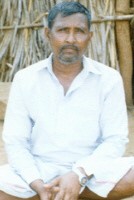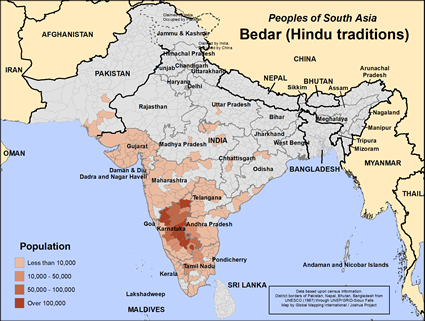Bedar (Hindu traditions) in India

Photo Source:
Copyrighted © 2026
India Missions Association All rights reserved. Used with permission |

Map Source:
People Group Location: Omid. Other geography / data: GMI. Map Design: Joshua Project
|
| People Name: | Bedar (Hindu traditions) |
| Country: | India |
| 10/40 Window: | Yes |
| Population: | 3,409,000 |
| World Population: | 3,416,200 |
| Primary Language: | Kannada |
| Primary Religion: | Hinduism |
| Christian Adherents: | 0.00 % |
| Evangelicals: | 0.00 % |
| Scripture: | Complete Bible |
| Ministry Resources: | Yes |
| Jesus Film: | Yes |
| Audio Recordings: | Yes |
| People Cluster: | South Asia Hindu - other |
| Affinity Bloc: | South Asian Peoples |
| Progress Level: |
|
Introduction / History
The Bedars are a Dravidian tribe in origin. "Bedar" comes from the word "bed" or "bedaru" meaning a hunter. Hindus are known as Bedar and Muslims as Berad. They prefer to be called Naikwadi because they serve as village policemen or Talwar (watchmen) or Naikmakkalu (chief's children). The Bedar language is a corruption of Kannada and Marathi languages. They have six social divisions.
What Are Their Lives Like?
The Bedar could be agricultural laborers, watchmen, stone cutter or herdsmen. They also work as servants, traders, messengers, police and soldiers.
Men and women wear silver and gold jewelry. Some traditionally shave their heads, wear waist girdles, gold and silver bracelets (khade) and gold earrings (muruva). Women tie their hair in a loose knot, wear nose-rings, a gold necklace and on their head they have a hooped silver ornament (dhora).
At the age of four or five girls are tattooed on the forehead, corners of the eyes, temples and forearms. Unmarried girls can be forced into prostitution. The girls are taken to a guru (spiritual leader) who brands them with a stamp, and then takes them to a temple where a necklace is tied around their neck in the name of the god, and they are now known as Basavi.
The boy's parents initiate marriage proposal. Child marriage is common, but the girl does not live with her husband until after puberty. Marriage cannot be within the same sub-division. They allow for widow remarriage and divorce. The Bedar have headmen (kattimani) to solve community disputes.
What Are Their Beliefs?
They have religious images made from silver, copper or brass. The Bedar either bury or cremate their dead.
They are non-vegetarian and drink alcohol. Bedar have faith in soothsaying, sorcery and astrology. Brahmins act as priests and in some places Lingayat Mathpati's serve as their priests. They celebrate Hindu festivals such as Diwali, Dussera, Holi, etc. Hindu Bedar identify all their gods with Rama. In Pune, Janai, Jokhai, Khandoba are the main deities. In Dharwad, the main deity is Hanmappa. In Solapur, the main deities are Ambabai, Jotiba and Khandoba. In Bijapur, the main deities are Durgava, Maruti, Venkatesh, Yellamma and Mallikarjun, which are often made into silver, copper or brass images. They observe Hindu festivals and have a hereditary guru. The Durgamuri Bedar carries the image of Durgamurgavva around in a box on their head.
What Are Their Needs?
The Bedar people need to put their trust and identity in the hands of the loving God of Creation who sent his son to make it possible for them to enter the Kingdom of God.
Prayer Points
Pray for the transformation of this community, thereby influencing the society through their profession as traders, messengers, police and soldiers.
Pray for a mighty impact of the JESUS Film and Christian radio broadcasting among this people.
Pray for Christian workers among them to resist the evil works of sorcery, soothsaying and witchcraft and demonstrate instead the power of the Holy Spirit.
Pray for the practice of child marriage to be abolished.